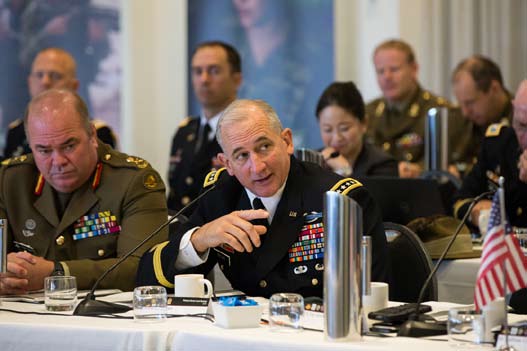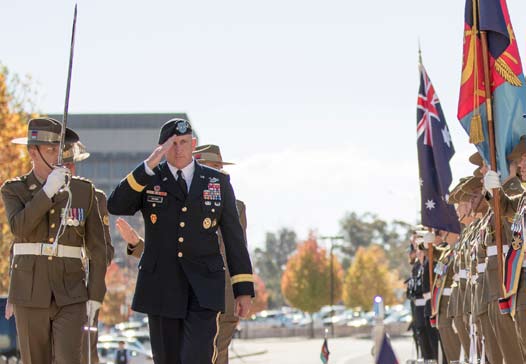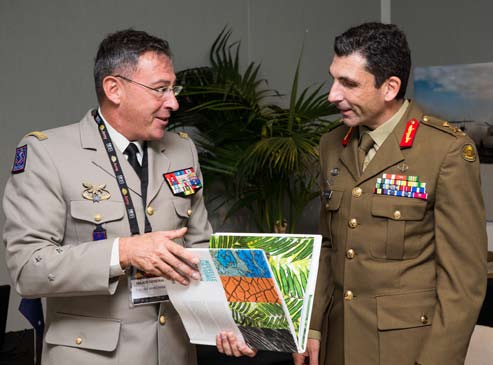General Robert B Brown
Commanding General, United States Army Pacific
Every generation thinks their time is the most complex in history, but it is hard to argue that it has ever been as complex as we find the global environment today, and in the Indo-Pacific region in particular. That complexity is changing the very character of warfare. When I was coming up through the ranks, the ‘fog of war’ was not enough information. This uncertainty was best mitigated through initiative—‘do something’. Now, what is the ‘fog of war’? It’s having too much information—mountains of information that must be sorted and prioritized. This proliferation of information and the ability to bring real time small unit updates to increasing levels of military hierarchy has had correspondingly deleterious impacts on initiative—dis-incentivizing it for fear of being second-guessed by those watching via sophisticated communications platforms as events unfold on the ground.
This changing and complex environment compels three imperatives for future land forces: (1) multilateralism in all we do; (2) joint integration; and (3) the development of multi-domain capabilities. And despite the promises of rapidly advancing technologies such as robotics, autonomous systems, and artificial intelligence… trusted, trained, and empowered people will be the key component of future land forces. It is no longer sufficient for our people to simply be comfortable in ambiguity and chaos. To win today and in the future, land forces require trusted teams of professionals that thrive in these difficult conditions.
A Rapidly Evolving and Complex Environment
There’s an old adage that ‘a lie is halfway around the world while the truth is still putting its pants on’. In a time in which the velocity and diffusion of information has increased so dramatically, the challenge of controlling or maintaining a strategic narrative has never been higher. Moreover, the speed with which information moves globally has bred a strategic impatience— people expect answers and information instantly. This hyper-connected world has made it possible for a few rogue players to have dramatic impact on many, as we’ve seen with non-state actors in the Middle East and elsewhere.
In addition to global complexity, the Indo-Pacific is the most complex region in the world. There are more people in this region than in the rest of the world put together. By 2050 it is estimated that six out of every ten people will live in this region—a fact which speaks to tremendous opportunities, but also tremendous challenges. We are also now in an era of hyper-competition. As articulated in the 2018 National Defense Strategy, ‘inter-state strategic competition… is now the primary concern in U.S. national security’. Our senior leaders recognize that continuous geopolitical competition is now the norm in the Indo-Pacific. In previous years, American military doctrine included a ‘Phase Zero’ on the spectrum of conflict. Phase Zero represented the pre-conflict period when, aside from national-level shaping operations, very little was occurring. We don’t use that terminology now because we are in a state of constant, hyper-competition, across all elements of national power—diplomatic, military, economic, and information.
Regime-based threats remain a significant concern in the Indo-Pacific. My professional life changed dramatically over the last couple of years as threats from North Korea significantly sharpened the focus of US military force in the region. While there has been much institutional goodness in focusing our military readiness efforts, we earnestly hope for the success of diplomatic solutions. No one wishes for conflict on the Korean Peninsula. However, our job as professionals—our sacred trust—is to be ready should diplomacy fail.
That is an imperative that will never change.
Beyond state-based threats, violent extremist organizations also contribute to regional instability. In 2017, the Philippines Government waged a five- month campaign to root out Islamic State militants entrenched in the city of Marawi. The crisis should serve as a wake-up call to us all, reinforcing the lesson that if we don’t work together, the violent extremists will find the seams and gaps among us. A positive example of effective cooperation currently in action is the Sulu Sea Initiative—Indonesia, Malaysia, and Philippines working closely together to close a gap in the Sulu Sea exploited by violent extremists.
The most frequent and likely contributor to regional instability will remain natural disasters: earthquakes, tsunamis, typhoons, volcanic eruptions, and many other types of catastrophe. The unfortunate reality is nearly eight out of ten people who perish in natural disasters do so in the Indo-Pacific. Thus, the armies of the region will inevitably find themselves involved in disaster response, and our close cooperation and multinational interoperability is vital to the success of those efforts. The good news is that 35 out of 36 nations in the Indo-Pacific already work together to save lives in the wake of natural disaster; the only nation that does not is North Korea. One of the enduring lessons drawn from exercises and actual disasters over the years is that we cannot form the cooperative relationships during the crisis. The partnership must be forged before crisis occurs. The investment in relationships and multinational interoperability are critical and will ultimately save lives.
Additionally, because hyper-competition does not have to mean conflict, disaster response provides a common mission behind which competing states can unite. The largest annual exercise the United States does with China is the Disaster Management Exchange (DME)—now in its fourteenth iteration. Through a series of vignettes and regional disaster scenarios, the DME serves as a critical, cooperative link between the United States and the People’s Republic of China.
Finally, consider what one scholar has referred to as ‘black swans’. These are rare, high impact events that we don’t see or anticipate coming. The 1918 Spanish Flu or the terrorist attacks of September 11, 2001 are prominent examples of un-forecasted events that resulted in significant impact—in both cases loss of life. No one saw them coming. In reality, though, ‘black swans’ are occurring more frequently and will continue to do so in the hyper-connected world in which we live. Though we will still try to predict future crises, the ‘black swan’ will only reinforce the truism articulated by former Secretary of Defense Bob Gates: ‘When it comes to predicting the nature and location of our next military engagements, since Vietnam, our record has been perfect: we have never once gotten it right.’ Complementing the ‘black swan’, the ‘pink flamingo’ is the inevitable surprise—a high impact event widely known, but ignored because of rigid organizational structures and bureaucratic decision-making processes. A prominent example in the contemporary operating environment is the ‘gray zone’ information operations we see executed by some nation states. We know these operations are occurring, but our cognitive biases and bureaucratic structures sometimes prevent us from anticipating possible effects.
Character of Future Land Forces
With the aforementioned complexity as context, what will characterize the land forces of the future? I would offer three imperatives for land forces to successfully compete, deter, and win in future operating environments: (1) multilateralism in all we do; (2) joint integration; and (3) the development of multi-domain capabilities.
First, multilateralism enables us to gather a variety of different perspectives, which is invaluable in crafting creative solutions to the problems land forces may face. In that spirit, US Army Pacific maintains an Australian Army general officer as a deputy commanding general. This partnership—about six years old now—has proved invaluable in offering alternative solutions to many of the complex problems we face. This is not to suggest that multilateral approaches aren’t frustrating, because they absolutely can be. However, I am convinced that they always lead to more optimal solutions than a unilateral approach—especially at the strategic level. Beyond merely cooperating, though, our forces must be able to operate with one another. We often focus interoperability on the systems—communications, fires, logistics, etc. The reality is that our systems will always have challenges communicating, and though we should not stop pursuing perfection, we must take a more expansive view of interoperability, to include procedures and relationships. Procedural interoperability ‘involves standardized communication, and agreed-upon terminology, tactics, techniques, and procedures that minimize doctrinal differences’. While we will always remain frustrated by—and often focused on—systems interoperability, procedural interoperability should not be overlooked as a way to enhance our cooperative effectiveness.
Finally, the most important dimension of interoperability is the personal relationships. When we cultivate strong relationships among partners, we are able to overcome the friction inherent in today’s complex operating environment, especially at the outset of crisis.
Second, there is a level of jointness required in the future unlike anything we have ever seen before. Joint integration—as opposed to simply joint interdependence—will be imperative in future conflict. Such a relationship among services provides additional options, which will be vital in an environment where we may not have dominance in all domains. And much like multilateralism, approaching problems with a joint perspective enhances the overall effectiveness and creativity of solutions. A good example of effective joint integration is evident in the evolution of the Rim of the Pacific (RIMPAC) exercise that occurs each year in Hawaii and surrounding areas. Two years ago, we asked the U.S. Navy to turn RIMPAC from the largest maritime exercise in the world to the largest multi-domain exercise in the world. They enthusiastically agreed, and this past year we were able to integrate U.S. Army, Australian, Japanese, and Special Operations assets into an exercise that included cross-domain fires, coordination, and synchronization all networked together across a common communications platform. Though the exercise represented a number of ‘firsts’, it by no means will be the last because joint integration will undoubtedly remain essential in future warfare.
Finally, multi-domain operations (MDO) is the future. We have to be capable of operating across multiple domains, or we will be irrelevant. MDO is an evolutionary concept that will have revolutionary impacts. While it took over a decade to codify the AirLand Battle concept into military doctrine, we cannot afford to take that long with multi-domain operations. As a warfighting concept, MDO will present multiple dilemmas to adversaries, while preserving multiple options for decision-makers. Because excelling in a multi-domain environment requires the kind of joint and multi-national collaboration described previously, MDO will require a greater investment in the development of our people. The complexity of the environment and the velocity of action necessitates that the future force develops people that are critical and creative problem solvers empowered to exercise disciplined initiative. This imperative will influence the way we matriculate, train, and retain our people. Trusted teams of professionals that thrive in ambiguity and chaos will necessarily be the cornerstone of the future force if we are to meet the challenges of a multi-domain and complex operating environment.


Figures 38 and 39. Commander US Army Pacific, General Robert Brown (centre), accompanied by US Army Pacific Deputy Commanding General - North, Australian Army officer Major General Roger Noble, speaks at the Trilateral Senior Level Seminar where US, Australian and Japanese senior leaders confer and discuss common defence issues. Right: General Brown inspects members of Australia’s Federation Guard during a visit to ADF HQ in 2018. (Images: DoD)

Figure 40. Deputy Chief of Army, Major General Justin ‘Jake’ Ellwood receives a gift about New Caledonia from Major General Thierry Marchand, Commander French Armed Forces in New Caledonia during CALFS 18. (Image: DoD)
Endnotes
- United Nations, “World Population Prospects 2017.” Available at https://population. un.org/wpp/. Accessed 13 October 2018.
- “Introduction,” 2018 National Defense Strategy. Washington D.C., 2018.
- United Nations Environment Programme. ”Building Resilience to Disasters and Conflicts.” Available at https://www.unenvironment.org/regions/asia-and-pacific/ regional-initiatives/building-resilience-disasters-and-conflicts. Accessed 18 October 2018.
- Taleb, Nassim Nicholas. The Black Swan: The impact of the highly improbable. Vol. 2. Random house, 2007.
- Gates, Robert M. “Address to the Corps of Cadets.” Speech, West Point, NY. February 25, 2011. Accessed October 2, 2018. http://archive.defense.gov/Speeches/Speech. aspx?SpeechID=1539.
- Gamble, Duane A. and Michelle M.T. Letcher. “The Three Dimensions of Interoperability for Multinational Training at the JMRC.” Available at https://www.army.mil/ article/173432/the_three_dimensions_of_interoperability_for_multinational_training_at_ the_jmrc. Accessed 12 October 2018.
- For a full discussion on AirLand Battle, see Romjue, John L., From Active Defense to AirLand Battle: The Development of Army Doctrine, 1973-1982. Historical Office, US Army Training and Doctrine Command, 1984.

